|
Frederick & Frances Sommer Foundation -
we appreciate the experiences that people had over the decades with Frederick
Sommer and on occasion people gather them up in such a way that we can post them
to the website. Charles Weatherby did so and is shared here in its
entirety.
Notes and Quotes:Frederick Sommer
Photography Workshop
Sun Valley Center for the Arts and Humanities
Sun Valley, Idaho, June 21- 27, 1976
By Charlie Weatherby
A PDF of this page
here
In the summer of 1976, I was a 33 year old
social work supervisor for the Idaho Department of Health and Welfare.My
interest in photography had been encouraged by a former classmate at Virginia
Commonwealth University School of Social Work, Glenn Scarboro.At the time
Scarboro was an accomplished photographer who had his first solo show at VCU’s
Anderson Gallery in 1973.He had grown up in Danville, VA, and was a good
friend of the photographer Emmet Gowin, who is well-known in his own right and
on the faculty at Princeton University.Scarboro had turned me on to Sommer’s
work and when I heard he was going to conduct a workshop at Sun Valley, I jumped
at the opportunity.I had little formal photography background at the time and
my knowledge of the medium was mostly from reading and attending an adult
education class in basic photography.
It would be an understatement to say that I felt completely out of my element
when I arrived at the workshop.My roommate for the week was Cyril Ryan, an
Aruba-born artist from Montreal who had an impressive resume.Others in
attendance included Dennis Hearne, who is on the faculty at San Francisco Art
Institute, Peter deLory, an instructor at the Sun Valley Center, Craig
Gullickson from the Red River Arts Center in Moorhead, MN, and Tina Barney from
Watch Hill, RI, who specialized in colorful prints of the well-to-do in that
part of the world.These people spoke a language I didn’t understand and I
inwardly vowed to keep quiet, listen attentively, and try not to make a fool out
of myself.Compounding my anxiety was the fact that Fred spoke in cryptic,
oblique, and impenetrable language that left me pondering what I was doing
there.My reaction was to settle back, watch, listen to the discourse, and take
copious notes.Here are some of the highlights, with the quotes belonging to
Fred.
Tuesday, June 22nd:
George Brock on subject matter- “The fog lifted and subject matter appeared.”
(I have no idea who George Brock is, or was at that time.A web search yielded
no clues).
“Question yourself.Keep going back and redoing what you’ve already done.”
In a discussion about seeing in black and white, Fred says that he “only sees in
position and occupier.”
On color photography- “You can buy little vials of color paint at the store and
put them up on your shelf and look at them.Then, having seen color, you can go
out and photograph in black and white.”Fred once shot about four rolls of
kodachrome.It cured him of color forever.On color- “You can’t do it at all.”
“We’re living in an aesthetic society.I believe in what I see, feel, taste.”
“More group thinking is needed.Thinking cannot be a lonely procedure anymore.
There are flaws in our perception- we can be easily sidetracked.You do as well
as you can and this is a contribution.”<
“Make an environment for yourself.Enjoy sleep, but don’t wake up to trivia.
Work to eliminate trivia.”Fred says that he sometimes wakes up in the middle
of the night after dreaming and can pick up the most difficult book and get into
it clearly- because the trivia has been eliminated.
“I am for today- here.”
“You can bring entrees to a situation- there have to be links to photos or other
things.”
“We see in twin conditions- black and white.On the black-white scale, nobody
has seen a real black or a real white.They are complementary to one another.”
“We are only employing our time well when we are employing several conditions.
One condition is next to a vacuum.Forget thinking about what you see.Take
pictures and then accept the consequences of what you did take.Take the one
picture out of many that has more than the others.Edit.You will find that
there is some degree of comfort with all of them.”
“You must get out.Aesthetics is interested in what you made today; you can
never balance the books.Enjoy the encounter rather than what you did.Choice
isn’t arbitrary- you give consent.You can state clearly what is positive and
why it is working.”
“We are just the bystanders- it isn’t happening to you.We need to condition
ourselves so that someday we can be just the bystanders.The voyeur does not
have a cohesive curiosity about the world.”
Fred talking about the advantages of long, rectangular framing- “The eye travels
in long rectangles naturally- it’s the way we’re hinged.”
On cropping- “If you can see it, you are dealing with it.If you see that it
(photo) can be improved, than you can crop- only after dealing with the
structure that will be eliminated.35mm can be a limiting framework.The
solution of any problem is compression.”
Alex Jamison was Fred’s apprentice at the time.Alex- “Only when the frame is
not defined is it arbitrary.”
“Why not pay attention to what your two eyes are seeing?”
Cyril Ryan initiates a discussion about one of Fred’s prints- “The Thief Is
Greater Than His Loot, 1955”.Fred discourses on the quality of the act of
taking.“Do you like it?If you take a guy’s shirt, they can find you.If you
take his soul, it’s harder to trace.You take something cohesively- that which
is important (structure?) and hide it well.”

Fred thinks that his work is some of the greatest done by a white man in North America.
“Get a library- it helps in the taking.”
He contrives the life that exists in something else (some older system).
“You can learn more from terrible reproductions than the good ones.Learn from
alternatives- read the conditions.Enrich some aspect of them.Find loot
greater than the thief.”
“Don’t read books you can understand- you pick things up and get some drifts and
make some sense.”Fred has as many books as possible that are different.He
understands them in chunks and by their possibilities.“Come along as a packrat
and rearrange the order.”
Fred on himself: “No radical changes, just modifications.”
He has written musical scores without knowing music theory.“The thieving of
musical scores is done by a visual process rather than by hearing.”
“Position and occupier is going to be important in logic.Interval is going to
be important in this positioning.I am concerned with linkages and their
maintenance. The trick is to see if something can work in another way.”
Afternoon session in the darkroom with Alex Jamison:
In looking at prints- bright spots such as sky, snow, and water can be
distracting and draw the eye away from what’s happening.
Pay special attention to the edges of the photo- levers (fulcrums, action) add
to the photo.Check the corners, the far reaches of the print; complementary
variety can help.
See photos on a grid- position, occupier.
Wednesday morning, June 23rd:
Fred- “You need to pay exaggerated attention to making a print.There is no
shotgun solution.Every print needs a tailor-made solution.The solution
doesn’t come out shrieking at you.”
“What is in the photo situation is more than a three dimensional world.”
“Have speculations or desires backed-up by alternatives.”
“Curiosity in printing must be at least equal to the curiosity in taking the
photo.Openness to conditions can sometimes lead to ‘happy accidents’.”
Alex- “Do justice to the possibilities of the negative- do justice to yourself.”
“Failures don’t have to be total.Examine and study prints exhaustively.”
“Most photos fail- it’s a shock when they work out.”
“Subject matter is harmless, but can be charming to the point of distraction
from other elements.”
“A photo or painting is a ‘light shed’- a logic of reflectances in the print.
This does not necessarily match what was there as the photo was taken.”
Alex- “Luminosity consists of transitions and not cleavages.”
“We’re dealing with a flat, two dimensional surface.Move away from contrast.
It’s amazing how much wiggling we can do and make a good print.There is much
latitude if you have a good negative.Get as much information on the negative
as possible.”
“The photo industry could do us a favor by coming out with a lower scale paper.”
“Nature is not a statement for the sake of a statement.”
Fred advises as much exposure as possible to the fine arts.
“A print should convey a cohesive state of affairs.”
In making negatives- from correct exposure according to meter take on, than
one-third of a stop over and one-third of a stop over.Then one-third of a stop
over and under these for a total of five negatives.
“In making negatives, we are always dealing with a package of unknowns.For
example, indicated shutter speeds may not be entirely accurate due to heat or
cold.”
“One good thing about color- you can let someone else develop it.”
“Follow your feelings- don’t do something any less well than you can do.Don’t
block out anything.Look at as much art as possible.Look at structure- deal
with things structurally.Art is the best way of seeing- it is older than
science.”
“You can get knowledge from someone without imitating them.It’s impossible to
make private art or literature.The degree to which a person finds a new
cohesion with a personal touch- he will be interesting to others.”
“If someone is close to something, he can help you to understand.The cohesion
of what happens to us is interesting to others.”
Talking about “gimmicks”- “Emmet Gowin neutralizes levers by reducing the field-
the levers out to the edge.He reduces the possibilities ultimately, making
things simpler for himself.”
“The burden of the photo is not the subject matter, but the structure.Art is
not arbitrary. It deals with a structural state of affairs.”
In the process of making pictures or the urge to build, etc. - “We cannot make
the formula before the fact.”
In looking at art- “Focus on that which deserves attention.What is
unaccountable in a work of art- this must be respected.Study failures- look at
what works- even examine those things with which you are at odds.There is no
such thing as ‘conceptual’ art.Art is a map; it is something that exists in
space.Aesthetic logic is finding the map, not attempting to make any
judgment.There is a need for respect for quality of perception.The Buddhists
believe that if you kill another person, you are wiping out their sense
perception.”
Maps are graphs of something.
“Nobody knows what life or death is, but every now and then one of us gets a
whiff of it.”
Ralph (art historian at Kent State) and I conclude that what Fred is teaching is
the process of removing obstructions.
Thursday morning, June 24th:
Fred spends a lot of his time making drawings and musical scores.
Alex- “The medium for both luminosity and legato is the grays.”
“Increased contrast works against resolution.”
Fred uses Azo paper for contacts and Ilford for some prints.
Fred shows us fifteen of his prints- Pencil on Foil, A Thief Is Greater Than His
Loot, Frances, Olivia, Dead Horse, several wall sections, and two cut
abstractions.
Talking about his prints- “I don’t pursue anything, they pursue me.”The cut
paper abstractions are some of his later prints.The outdoor photos are
earlier.Discussion of his “chicken guts” photo (1939). “This wasn’t serious
subject matter to begin with.”
Some of his photos are designs he lays out on cardboard- he shoots down on
them.He showed us one that was white dust streaks on a black charcoal
background.“In the beginning, other photographers would only tolerate the
photos.Painters were immediately interested in them.Edward Weston was
initially pleased with them and thought they should gain wide acceptance.This
was not so easy.”
Fred talks about how good aperchromatic lenses are.Some of his exposures are
for as long as fifteen seconds with lenses with no shutter.Take the cap off
and put it back on for exposure.“You can lose a little definition for the sake
of an overall depth of field.”
On his print techniques- Rubbing on foil with an instrument and then holding it
over a candle.Turns it over and adds some Vaseline.Lays it down and lets the
soot settle on a glass sheet.Sticks it in the enlarger.You can also heat up
cellophane and put it in an enlarger for an unusual effect.
Peter deLory asks about how he really came about taking the “amputated leg”
photo.A physician friend of Fred’s was interested in photography and had seen
the “chicken guts” photo.One evening a young hobo had his leg cut off in a
railroad accident.He was brought to the physician, who immediately amputated
the leg.He wrapped the amputated leg in newspaper and took it to Fred.Never
one to pass up a good opportunity, Fred took some photos of it and returned it
to the physician.The hobo made a good recovery.“Working with dead things is
harmless.”
“Minor White has respect for all kinds of things, but not linguistic logic.”
“Don’t use soft papers for remedial means.Expose and develop correctly.”
Fred and Alex have experimented with mapping light gradations on prints.They
map the print out like a topographic contour map.Between every two lines is a
grade of light.They have cut layers of polyethylene according to the contour
lines and placed them on top of each other according to the light grade.Then
they have to make only one exposure to get a “correct” print.They use report
covers for this process.This is not too workable for 35mm but is better for
4x5 and 5x7.
“Some people see photography as the back door of art.The problem is that it’s
so diabolically easy and yet it’s harder than anything.”
“Art is the longest record that we have of man’s encounter with his surroundings
and himself.”
“Early on in photography it was a struggle.You people at least can exist.
Maybe not with all of the help and appreciation you think you need, but not
emotionally scared.”
“Study the arts and their history for the purpose of broadening your base.You
can’t go any farther forward than you can go backward.”
Thursday evening:
Fred talks of his experiences in Japan five or six years ago.He became
particularly interested in Shinto.“It’s a natural religion- how man stands
before the universe.”
“We can’t see ourselves unless we can see the acts of others.”
“Aesthetics is honoring our perceptions of a state of affairs.”
“More than producing art, we should live an artful existence.”
“Living in an aesthetic society is a matter of manners.We are no better than
the cohesion of the families making up our society.”
“Nothing else dies in the world except perceiving.When you kill someone, you
kill their perception.”
“There are no good or bad acts.Nietzsche said this, but too forcefully.”
“We can only give consent to what we are, and what we are is what we feel.”
“We need to have respect for the materials of art and the materials of life
(food).”
“It is very important not to complicate ones’ life.Eliminate trivia.”
“If there is any wisdom in man, it is in his eyes and his taste buds.”
Thursday afternoon:
Cyril Ryan joined me for a short road trip north of town to look for images.I
snapped five exposures just off the road in the Trail Creek area and later spent
time working the best negative in the darkroom over the next two days.Here’s
the result:
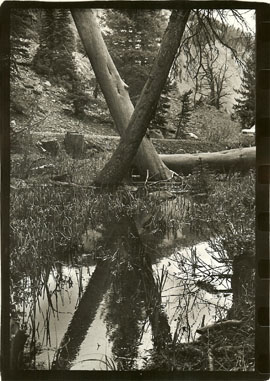
“Crossed Trees”
Friday morning, June 25th:
Fred views student’s prints.
“Don’t present the notion that the light outside the print is stronger than the
light inside.”
“Don’t give up working in contrasty ways if you know what you’re giving up.”
“Softer paper with strong developer will decrease muddiness.”
Contrast problems keep popping up.“Information in the print can conflict.The
pieces do not support one another.”
“A live picture can ‘breathe’.It is like a pendulum swinging back and forth.”
(Try Selector of Selector Soft developer for softer printing.This can also be
mixed with Dektol.Selectol 1:2, 1:3.)
“You can give up definition for depth of field.”
“Some prints really look nice with a little bit of reducing and toning.Very
little.If in doubt, dry the print and then soak it in reducer.”
“There is no advantage to having 12 prints just on the edge of being good when
you can have one that is super.Quit dreaming about what else is out there.
Work on what you have.”(Agfa Portriga matt paper- very nice for soft, grainy
prints).
Dennis Hearne- In printing- 2 to 2 ½ minutes in Dektol.He starts with a high
concentration and works down.Sodium Thiosulfate (hypo)- for non-hardening
mixing with reducer- double strength plain hypo.
Reducer is very powerful and should be the color of weak urine.Touch up and
wash quickly.Kodak Rapid Selenium Toner is good.
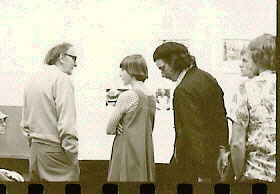
Saturday morning, June 26th:
“Richness of awareness is not going to be available to us as an exception.”
“We don’t know how we got here, or how we will leave, and good luck in between.
Take this attitude to your photos.”
“Become aware of what things are.Just be there.”
We all take our beatings.Fred talks of the similarity of taking a beating to a
pruned plant.It regenerates and is stronger.What we have been talking about
all week is “less photographing than managing your own condition.To do this,
you need organization… and controlled panic.You also must do your homework.”
Fred recommends looking at art history as a map and to ignore what is said.
“Out of confusion (cataclysm) comes order.Chance creates order.”<
Saturday evening: barbeque attended by Fred, his wife Frances, instructors,
and students.
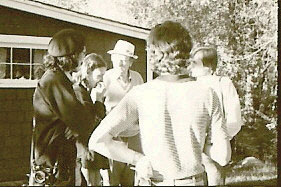
Sunday morning, June 27th:
“Linguistic logic is the only mechanism to link diverse areas."
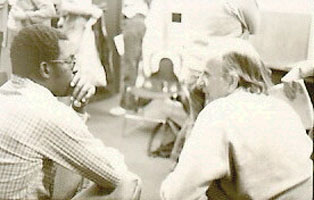
Cyril Ryan ponders Fred’s linguistic logic.
Postscript- June 2006
Frederick Sommer died at home in Prescott, AZ, on
January 23, 1999.He was 94 years old.His wife Frances followed him in death
less than four months later.The headline of Margaret Loke’s New York Times
obituary called Fred a “Maker of Inventive, Surreal Images”.He was also called
“eccentric”, “a gadfly”, and “a photographer’s photographer”.His works are in
the collections of over 50 museums and galleries and there were more than 150
major exhibitions of his work from 1932 to 2006.The Center for Creative
Photography in Tucson and the J. Paul Getty Museum in Los Angeles are the two
major collectors of his photographs.The Frederick and Frances Sommer
Foundation’s website is a wonderful resource for anyone looking for information
on Fred’s life and work.
The students who attended Fred’s workshop are also, in retrospect, a highly
productive group of artists.
Fred’s workshop assistant,
Alex Jamison is an architectural and
freelance photographer based in Silver Spring, MD, and was a 1979 recipient of a
NEA Visual Artist Fellowship.He is an adjunct faculty member at George Mason
University and his work is in the collections of Addison Gallery of American
Art, the Corcoran Gallery of Art, Hamilton College, and Princeton University Art
Museum.
Peter de Lory is a San Francisco Art
Institute graduate and is a Seattle-based photographer who has had over 29 solo
exhibits.He is the recipient of numerous awards, including a NEA Photography
Fellowship in 1979.He has taught and lectured at over a dozen colleges,
workshops, and symposiums.
Andy Ostheimer is a Professor of Fine Arts at San Jose State University and
is Gallery Director for the School of Art and Design.Her photographs are in
the collection of the Daum Museum of Contemporary Art in Sedalia, MO.
Dennis Hearne is on the faculty of San Francisco Art Institute and is a
self-employed photographer.He was the recipient of NEA Photographers
Fellowships in 1974, 1979, and 1980.His Baja Project for the California
Historical Society was also funded by the NEA.His photographs are in the
permanent collections of the New York Museum of Modern Art and Fogg Art Museum.
David Hanson was an assistant to
Frederick Sommer and Minor White and also taught Photography and Landscape
Architecture at Rhode Island School of Design.He is the author of an Aperture
monograph, “Waste Land: Meditations on a Ravaged Landscape”, and his aerial
views of Colstrip, Montana are regarded as some of the most important of the
last 100 years.His work is in the permanent collections of major museums
worldwide, including the New York Museum of Modern Art and the San Francisco
Museum of Modern Art.
Julie Bruck is, in her own words, “a failed visual artist” who studied
photography as an undergraduate and realized she is “much better with word
pictures.Besides, photography entails hazardous chemicals.Poetry’s
non-toxic.”She has taught at Concordia University, received two National
Magazine Gold Awards for Poetry, and is the author of two books, “The End of
Travel” and “The Woman Downstairs.”Both are published by Brick Books.A
native of Montreal, she now lives in San Francisco.
Doug Plummer has been a commercial
photographer since 1985 and is based in Seattle.He has done photos for a
number of national corporations, magazines, and institutions and also does
portraits, wedding and travel photographs.His
weblog
is an interesting combination of
photos and essays on travel, digital, and analog photography.Doug was written
up in Photo District News in May 1995 and was quoted extensively in the 1998
Photographer’s Market “How to Put Together a Winning Portfolio”.In 2006, he
was a recipient of an International Color Award.
Wayne Gudmundson teaches photography at Minnesota State University
Moorhead.He has photographed the North Dakota landscape for over 35 years, and
his photos of Icelandic immigrants in Minnesota has focused on their connection
to upper Midwest austere landscapes.His work has appeared in eight different
books, including “Walking on Water” and “The Promise of Water; The Garrison
Diversion Project”, and his photographs are in many permanent collections.
Wayne also directs New Rivers Press, a literary teaching publishing house at
MSUM.His photographs are available through the Candice Perich Gallery of
Katonah, NY, and the Plains Art Museum in Fargo, ND.Wayne’s wife, Jane
Gudmundson, is also a photographer.The two collaborated on the photographs
for the book “Iron Spirits”, which is about the tradition of blacksmith-made
iron crosses, the people who made them, and the communities they serve.
Cyril Ryan was born in Orangestaad, Aruba in 1946.He now lives in Canada
and his work is in the collection of the National Gallery of Canada.
Frances Story has won several awards for her photography, including the Fine
Art Photography Merit Award from Franklin and Marshall College in 1985 and a 21st
Biennial Exhibition Merit Award from the University of Delaware in 1984.She
has had exhibitions at Philadelphia’s Moore College of Art, Newark, Delaware
Gallery 20, and the Wharton School at the University of Pennsylvania.
Tina Barney has been called “a kind of Diane Arbus of
the rich” and specializes in photographs of family and friends in their leisure
class surroundings.Her work is in many museums and public art galleries,
including New York Museum of Modern Art, Boston’s Museum of Fine Arts, San
Francisco Museum of Modern Art, Seattle Art Museum, Smithsonian Art Museum, Los
Angeles County Museum of Art, and Yale University Art Gallery.She has also
published two books, “Theater of Manners” (1997) and “The Europeans” (2005).
She has had fifteen major exhibits since 1998 and has also produced short films
on photographers Jan Groover and Horst P. Horst.Tina lives in Watch Hill, RI.
No information could be found on other workshop attendees Rick Broer,
Michael Gasaway, Craig Gullickson, and Michele Einhorn.
Charlie Weatherby, MSW, LCSW, is a recently retired social worker who worked
in adoptions and foster care for the last twenty-five years.He lives in Marin
County, California.His photographs were included in the 1st
Biennial Juried Exhibit for Idaho Artists in 1979 and Photography/Idaho Juried
Exhibit at the Minds Eye Gallery, Idaho State University in 1981.
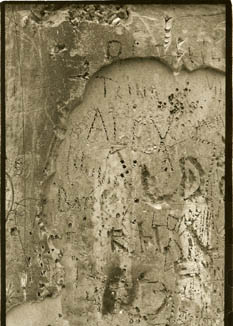
“Moonscape”
From 1st Biennial Juried Exhibit for Idaho Artists
[ RETURN TO TOP ]
|

